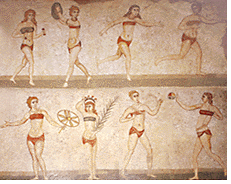...Best of Sicily
presents... Best of Sicily Magazine. ... Dedicated to Sicilian art, culture, history, people, places and all things Sicilian. |
by Ignazio Lo Verde | ||
Magazine Index Best of Sicily Arts & Culture Fashion Food & Wine History & Society About Us Travel Faqs Contact Map of Sicily |
It has been suggested by some historians that the red "swimsuits" in the mosaics are, in fact, undergarments. This is quite possible, but it is clear that such apparel also served as sportwear. It is interesting that the artist chose to render the figures clothed at all. The exercises are fascinating, dispelling the myth that certain athletic movements are modern ones. One figure is shown tossing what appears to be a leather "medicine ball" (though with one arm, suggesting that the ball is light), while one runs as another throws a discus --something introduced in Sicily by the Greeks. The girl lifting weights (apparently in what are known as "alternate curls" for biceps development) is perhaps the most captivating image, as writers on fitness topics seem convinced that women's bodybuilding is somehow a twentieth-century development. Details can be debated, but the mosaic implies that women competed (perhaps for female spectators) in particular sporting activities in this part of the Roman Empire around A.D. 300. The crowned figure holding the palm branch has been awarded a prize for winning such a competition. The women are rather muscular but show various body types. It is probable that certain elements depicted reflect older origins in other regions. In this context, the wealth of imagery known in ancient Egypt cannot be ignored, and it certainly influenced the Romans. This, however, does not detract from the importance of the Piazza Armerina figures, which, like the beauty of athletic grace, remains indelible in time. About the Author: Professor Ignazio Lo Verde lectures on classics and architecture. | |
Top of Page |
 Was the two-piece swimsuit invented in an ancient Sicily? In view of archeology and ancient history, it's a good question. In the Roman villa outside Piazza Armerina, an interesting mosaic suggests that the "bikini" was known in Sicily during the days of the Roman Empire. In this remarkable mosaic, the female figure shown exercising with dumbells puts to rest the theory that women's bodybuilding began in California.
Was the two-piece swimsuit invented in an ancient Sicily? In view of archeology and ancient history, it's a good question. In the Roman villa outside Piazza Armerina, an interesting mosaic suggests that the "bikini" was known in Sicily during the days of the Roman Empire. In this remarkable mosaic, the female figure shown exercising with dumbells puts to rest the theory that women's bodybuilding began in California.